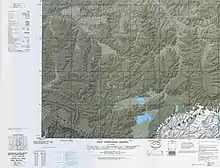Chiang-tzu
English

Map including CHIANG-TZU (DMA, 1977)
Etymology
From Mandarin 江孜 (Jiāngzī) Wade–Giles romanization: Chiang¹-tzŭ¹.
Proper noun
Chiang-tzu
- Alternative form of Jiangzi (Gyantse)
- 1963, Provincial Atlas of China, Joint Publications Research Service, →OCLC, page 55:
- Chiang-tzu is situated on the east back of Nien-ch'u River, a tributary of Yalutsangpo River. This is one of three large cities in Tibet, Chiang-tzu is renowned for producing Tibetan rugs , […]
- 1998, The New Encyclopaedia Britannica: Macropaedia: Knowledge in Depth, →ISBN, →OCLC, page 208, column 2:
- The first telegraph line was strung between Kalimpong (India) and Chiang-tzu by the British in 1904. In the 1920s another line connecting Chiang-tzu with Lhasa was erected, this being the only telegraph system in use until the Chinese took over in 1951.
- 2020, Evan McGilvray, “The Early Years”, in Field Marshal Claude Auchinleck, Pen & Sword, →ISBN, →OCLC, page 6:
- Auchinleck commanded one of these – a company of 100 men – with orders to establish a base at Gyantse (now renamed Chiang-tzu) over 150 miles inside Tibet and 12,000ft above sea level.
Translations
Jiangzi — see Jiangzi
This article is issued from Wiktionary. The text is licensed under Creative Commons - Attribution - Sharealike. Additional terms may apply for the media files.